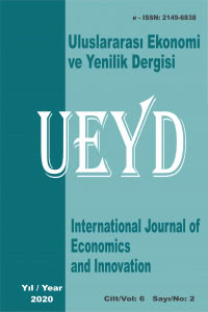Göç, İşsizlik ve Gelir Arasındaki İlişkilerin Analizi: OECD Ülkeleri Örneği*
Analysis of Relations between Migration, Unemployment and Income: The Case of OECD Countries
___
- Birleşmiş Milletler (2017). International Migration Report 2017.
- Bonin, Holger (2005). Wage and Employment Effects of Immigration to Germany: Evidence from a Skill Group Approach. IZA DP No. 1875.
- Borjas, George J. (2001). Does Immigration Grease the Wheels of the Labor Market? Brookings Papers on Economic Activity, 32(1), 69-134.
- Boubtane, Ekrame vd. (2013). Immigration, Unemployment and GDP in the Host Country: Bootstrap Panel Granger Causality Analysis on OECD Countries. Economic Modelling, 33(2013), 261-269.
- Bove, Vincenzo ve Elia, Leandro (2017). Migration, Diversity, and Economic Growth. World Development, 89, 227-239.
- Breusch, P. S. ve Pagan, A. R. (1980). The Lagrange Multiplier Test and its Applications to Model Specification in Econometrics. Review of Economic Studies, 11(7), 239-253.
- Di Maria, Corrado ve Lazarova, Emiliya A. (2012). Migration, Human Capital Formation, and Growth: An Empirical Investigation. World Development, 40(5), 938-955.
- Docquier, Frédéric vd. (2011a). Emigration and Democracy”, IZA Discussion Paper No. 5496, http://ftp.iza.org/dp5496.pdf (Erişim Tarihi: 20.06.2019).
- Docquier, Frédéric vd. (2011b). The Labor Market Effects of Immigration and Emigration in OECD Countries. IZA DP No. 6258.
- Dustmann, Christian vd. (2005). The Impact of Immigration on the British Labor Market. The Economic Journal, 115(507), 324-341.
- Eberhardt, M. ve Teal, F. (2011). Econometrics for Grumblers: A New look at the Literature on Cross‐Country Growth Empirics, Journal of Economic Surveys, 25(1), 109-155.
- Eberhardt, Markus ve Bond, Stephen (2009). Cross-section Dependence in Nonstationary Panel Models: A Novel Estimator. MPRA Paper No: 17692.
- Grogger, J. ve Hanson, G. H. (2011). “Income Maximization and the Selection and Sorting of International Migrants. Journal of Development Economics, 95, 42- 57.
- Islam, Asadul (2007), “Immigratıon Unemployment Relationship: The Evidence from Canada”, Australian Economic Papers, March, 52-66.
- Jean, Sebastien ve Jimenez, Miguel (2011). The Unemployment Impact of Immigration in OECD Countries. European Journal of Political Economy, 27, 241-256.
- Karemera, D., vd. (2000). A Gravity Model Analysis of International Migration to North America. Applied Economics, 32(13),1745-1755.
- Kim, Keuntae ve Cohen, Joel E. (2010). Determinants of International Migration Flows to and from Industrialized Countries: A Panel Data Approach Beyond Gravity. International Migration Review, 44(4), 899- 932.
- Lee, E.S. (1966). A Theory of Migration. Demography, 3(1), 47-55. Lewer, Joshua J. ve Berg, Hendrik Van den, (2008). A Gravity Model of Immigration. Economics Letters, 99, 164-167.
- Mayda, Anna M. (2007). International Migration: A Panel Data Analysis of the Determinants of Bilateral Flows. Discussion Paper Series, CDP No 07/07.
- Morley, Bruce (2006). Causality Between Economic Growth and Immigration: An ARDL Bounds Testing Approach. Economics Letters, 90(1), 72-76.
- Neumayer, E. (2005). Bogus Refugees? The Determinants of Asylum Migration to Western Europe. International Studies Quarterly, 49, 389-409.
- OECD (2018), International Migration Outlook, OECD Publishing, Paris.
- OECD International Migration Database, http://www.oecd.org/migration/mig/oecdmigrationdatabases.htm
- Ortega, Francesc ve Peri, Giovanni (2009). The Causes and Effects of International Migrations: Evidence from OECD Countries 1980-2005. NBER Working Paper Series, Working Paper 14833.
- Ortega, Javier and Verdugo, Gregory (2014). The Impact of Immigration on the French Labor Market: Why so different? Labor Economics, 29(C), 14-27.
- Pesaran, Hashem M. (2004). General Diagnostic Tests for Cross Section Dependence Panels. CESifo Working Paper Series No: 1229.
- Pesaran, Hashem M. (2007). A Simple Panel Unit Root Test in The Presence of Cross-Section Dependence. Journal of Applied Econometrics, 22 (2), 265-312.
- Pesaran, M. Hasheem, vd. (2008). A Bias-Adjusted LM Test for Error CrossSection Independence. Econometrics Journal, 11, 105-127.
- Pesaran, M. Hashem ve Yamagata, T. (2008). Testing Slope Homogeneity in Large Panels. Journal of Econometrics, 142 (1), 50-93.
- Petersen, William (1958). A General Typology of Migration. American Sociological Review, 23(3), 256-266.
- Pischke, Jörn-Steffen ve Velling, Johannes (1997). Employment Effects of Immigration to Germany: An Analysis Based on Local Labor Markets. The Review of Economics and Statistics, 79(4) 594-604.
- Ravenstein, E. G. (1885). The Laws of Migration. Journal of the Statistical Society, 48(2), 167-235.
- Shan vd. (1999). Immigration and Unemployment: New Evidence from Australia and New Zealand. International Review of Applied Economics, 13(2), 253-260.
- Steinhardt, Max Friedrich (2011). The Wage Impact of Immigration in GermanyNew Evidence for Skill Groups and Occupations. The B.E. Journal of Economic Analysis & Policy, 11(1), 1-33.
- Stouffer, Samuel A. (1940). Intervening Opportunities: A Theory Relating Mobility and Distance. American Sociological Review, 5(6), 845-867.
- Westerlund, Joakim ve Edgerton, David (2007). A Panel Boostrap Cointegration Test. Economic Letters, 97(3), 185-190.
- Zipf, George Kingsley (1946). The P1P2/D Hypothesis: On the Intercity Movement of Persons. American Sociological Review, 11(6), 677-686.
- ISSN: 2149-6838
- Yayın Aralığı: Yılda 2 Sayı
- Başlangıç: 2015
- Yayıncı: Seyfettin Artan
İşgörenlerin Örgütsel Politika Algısına Tepkilerinin Belirlenmesinde İş Tatminin Rolü
İnovasyon Etkenlerinin Araştırılması ve Optimal İnovasyon Portföy Yapılanması
Kadınların İstihdamı ve Boşanma İlişkisi: Türkiye Üzerine Ampirik Bir Analiz
Financial Performance Evaluation of Food and Drink Index Using Fuzzy MCDM Approach*
Göç, İşsizlik ve Gelir Arasındaki İlişkilerin Analizi: OECD Ülkeleri Örneği
The Relationship between Women’s Employment and Divorce: An Empirical Analysis on Turkey
Financial Performance Evaluation of Food and Drink Index Using Fuzzy MCDM Approach
İnovasyon Etkenlerinin Araştırılması ve Optimal İnovasyon Portföy Yapılanması*
Melike METERELLİYOZ KUYZU, Tunahan TAYAR
Türkiye’de Yenilenebilir Enerji Tüketimi, Tarım ve CO2 Emisyonu İlişkisi
